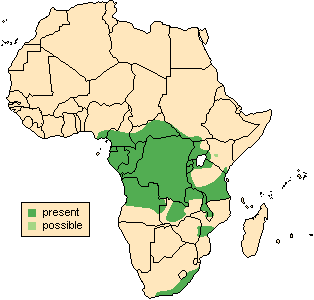![]() Return
to Artiodactyla
Return
to Artiodactyla
Classification
|
 Philantomba
monticola
Philantomba
monticola
Blue duiker
![]()
Taxonomy
 |
 |
 |
Click on the images above for a larger view of the
photographs
|
||
General Characteristics
Body Length: 50-75 cm / 1.6-2.5 ft.
Shoulder Height: 30-40 cm / 12-16 in.
Tail Length: 7-10 cm / 3-4 in.
Weight: 3.8-5.4 kg / 8.4-12 lb.Females are generally larger than males in this duiker species. The colour of the coat varies with the region from slate grey to grey-brown, with a bluish sheen on the back. The underparts, inner legs, rump, and underside of the tail are whitish. There is a light eye-brow ridge which curves up to the base of the horns, as well as a glandular slit underneath the eye. The horns are strongly ridged and short, growing 2-10 cm / 0.8-4 inches long. The horns are sometimes absent in females, or hidden by the short head crest.
Ontogeny and Reproduction
Gestation Period: 7.5 months.
Young per Birth: 1, rarely twins.
Weaning: By 5 months.
Sexual Maturity: Females at 9-12 months, males at 12-18 months.
Life span: 10-12 years.Kids lie concealed away from the mother for 2-3 months. At this point their coat changes from reddish brown to the grey-blue colour of adults.
Ecology and Behavior
The blue duiker is mostly active at night and at dawn and dusk. Bonded pairs patrol their territory, which are 2.5-4 hectares in size, regularly marking them with scent clues from their pedal glands (situated between the hooves), facial glands, and from defecating. Both sexes chase off any intruders, but will remain tolerant of their own young until they reach 18 months of age. The mother and young contact through soft groaning calls, both freezing at the slightest alarm. Males may emit a whistle or a sneezing sound to raise the alarm. Population densities of up to78 per square kilometer have been recorded in Gabon.Family group: Solitary or in mating pairs.
Diet: Leaves, buds, shoots, grasses, fruit, insects, eggs.
Main Predators: Leopard, small cats, civet, eagle, crocodile, python, monitor.
Distribution
Rain and riverine forest, dense thickets, and montane forests up to 3,000 m / 10,000 feet.

Range Map (Redrawn from IEA, 1998)
Conservation Status
The blue duiker is fairly common and is not endangered
Remarks
The bluish-grey tint of the coat in certain regions accounts for the name "blue". Duiker ("DIKE-er") is Africaans for "diver", due to their habit of bounding into the undergrowth when alarmed. Mons (Latin), genitive montis, a mountain; colo (Latin) I cultivate, can mean I inhabit; hence monticola (Latin) dweller among mountains.
Literature Cited
Alden, P. C., R. D. Estes, D. Schlitter, and B. McBride. 1995. National Audubon Society Field Guide to African Wildlife. New York: Chanticleer Press.IEA (Institute of Applied Ecology) 1998. Cephalophus monticola. In African Mammals Databank - A Databank for the Conservation and Management of the African Mammals Vol 1 and 2. Bruxelles: European Commission Directorate. Available online at http://gorilla.bio.uniroma1.it/amd/amd018b.html
Kingdon, J. 1997. The Kingdon Field Guide to African Mammals. Academic Press, London and New York: NaturalWorld.
Nowak, R. M. [editor]. 1991. Walker's Mammals of the World (Fifth Edition). Baltimore: The Johns Hopkins University Press.
Walther, F. R. 1990. Duikers and Dwarf Antelopes. In Grzimek's Encyclopedia of Mammals. Edited by S. P. Parker. New York: McGraw-Hill. pp. 325-343.
Wilson, D. E., and D. M. Reeder [editors]. 1993. Mammal Species of the World (Second Edition). Washington: Smithsonian Institution Press. Available online at http://nmnhwww.si.edu/msw/
Return to Artiodactyla

![]()
© Brent Huffman, www.ultimateungulate.com |
|
|